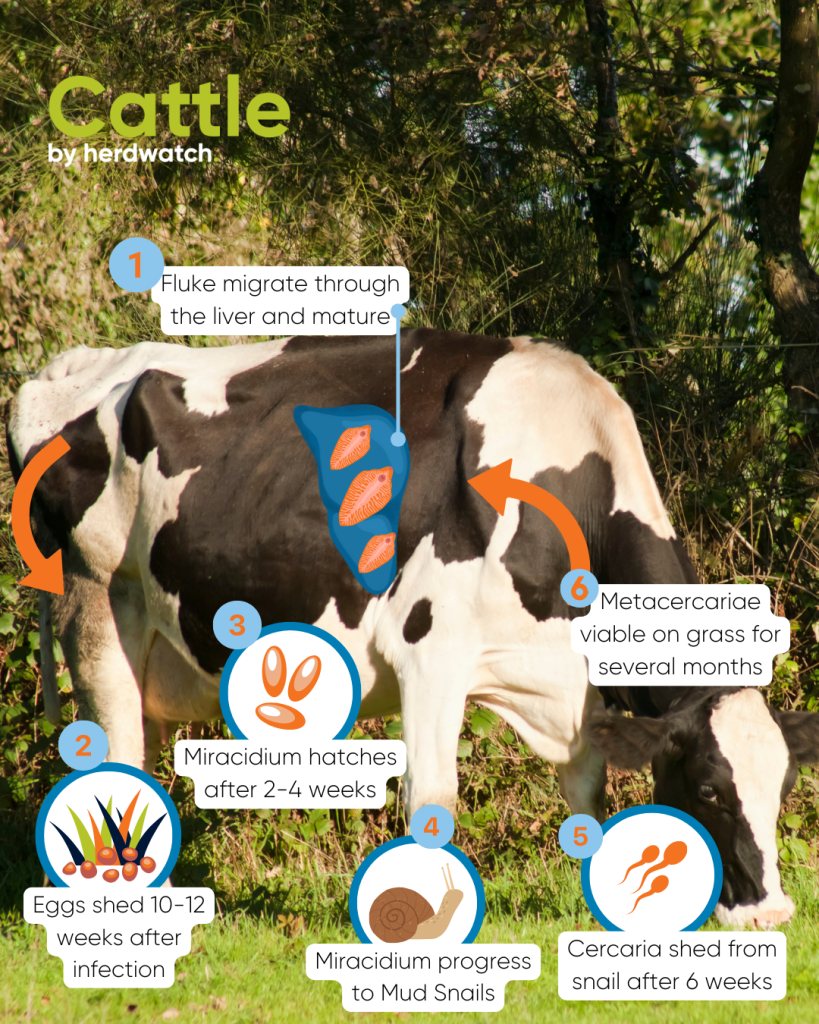Liver Fluke in Cattle and Sheep: Prevention, Diagnosis, and Control Strategies

Liver fluke, caused by the parasitic flatworm Fasciola hepatica, poses a significant threat to both cattle and sheep, leading to considerable economic losses in the UK livestock industry. Understanding its life cycle, recognising clinical signs, and implementing effective management strategies are crucial for farmers to mitigate its impact.
Life cycle and transmission
The liver fluke’s complex life cycle involves an intermediate host—the mud snail (Galba truncatula). These snails thrive in damp, muddy areas such as the edges of water bodies, ditches, and boggy pastures. In the UK, liver fluke development on pastures typically occurs from mid- to late spring through early autumn, with pastures becoming most infectious between August and October. However, due to the resilience of the parasite’s cyst stages and the overwintering capability of infected snails, pastures can remain infective for most of the year. Both cattle and sheep are susceptible to infection, and cross-species transmission can occur when they graze the same contaminated pastures.
Economic and welfare implications
Fluke infections are estimated to cost the UK agricultural industry around £300 million annually (AHDB). Losses stem from clinical disease, reduced milk yield, diminished growth rates, and increased susceptibility to other infections such as Salmonella and Black disease, especially in unvaccinated animals.
Clinical signs and diagnosis
In cattle, acute liver fluke disease, resulting from extensive liver damage by migrating juvenile flukes, is less common but can occur in early autumn. More frequently, chronic infections manifest in late autumn and winter, characterised by;weight loss,poor performance, occasionally, signs like bottle jaw or brisket swelling due to severe protein deficiency. Diarrhea may also be observed, possibly linked to lowered immunity to other diseases. In sheep, fasciolosis can range from sub-clinical infections to sudden death in severe acute cases.
Diagnosing liver fluke involves several methods:
- Post-Mortem Examination: Liver damage and the presence of flukes are easily identifiable during necropsy or at slaughter.
- Faecal Testing: Detecting fluke eggs or copro-antigens in faeces can confirm current infections. However, egg detection is only possible from 12 weeks post-infection when adult flukes begin shedding eggs.
- Antibody Testing: While this can indicate exposure, it may not differentiate between current and past infections.
Management and control strategies
Effective control of liver fluke involves a combination of strategies:
- Pasture Management: Identify and limit access to “flukey” pastures—wet, boggy areas where mud snails are prevalent. Implementing drainage and fencing off these areas can reduce exposure.
- Co-Grazing Practices: While co-grazing cattle and sheep can reduce the risk of certain parasites like roundworms, it does not diminish liver fluke risk. Both species can act as reservoirs, contaminating pastures with fluke eggs.
- Treatment Protocols: Regularly treat livestock with appropriate flukicides, especially during high-risk periods. It’s essential to choose effective products and administer them correctly to prevent resistance.
- Monitoring and Testing: Regularly monitor livestock for signs of infection and conduct diagnostic tests to inform treatment decisions. Abattoir feedback on liver condemnations can also provide insights into herd or flock health.
Using Herdwatch for medication records and compliance
Effective fluke control often requires the strategic use of flukicides, making accurate record-keeping essential for both herd health and regulatory compliance. Herdwatch simplifies medication record keeping by allowing farmers to log treatments in real-time, track withdrawal periods, and ensure compliance with veterinary regulations. With Herdwatch, farmers can easily generate reports for farm audits and ensure that fluke treatments are administered correctly and on schedule, reducing the risk of resistance and improving overall herd health.
By understanding the liver fluke’s life cycle and implementing integrated management practices, cattle and sheep farmers can effectively reduce the burden of this parasite and safeguard their livestock’s health and productivity.
